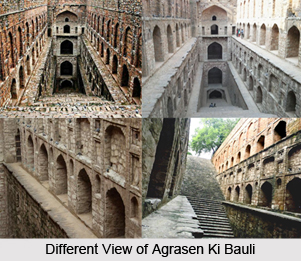 Agrasen Ki Bauli, also referred to as Agar Sain ki Baoli or Ugrasen ki Baoli is a historical step well located near Connaught Place, Delhi. The Archaeological Survey of India or ASI has been entrusted the responsibility of preserving this ancient building under the Ancient Monuments and Archaeological Sites and Remains Act, 1958.
Agrasen Ki Bauli, also referred to as Agar Sain ki Baoli or Ugrasen ki Baoli is a historical step well located near Connaught Place, Delhi. The Archaeological Survey of India or ASI has been entrusted the responsibility of preserving this ancient building under the Ancient Monuments and Archaeological Sites and Remains Act, 1958.
Agrasen Ki Baoli measures about 15 metres in width and 60 metres in length and is based at a short distance from Jantar Mantar. Though there is absence of concrete historical evidence which identify the creator of this monument, it is said that it was constructed by Agrasen, who was the legendary ruler during the age of the Mahabharata. It was believed to have been reconstructed by the Agrawal community during the 14th century. Its origin dates back to the times of Maharaja Agrasen.
The word `bauli` is obtained from a Sanskrit term called `wapi` or `vapika`. This word gave birth to a Hindi word `bauri` or `baori` which implies bauli. As per the dialects used in the Indian states of Gujarat and Rajasthan, step well is also referred to as `vavadi`, `vav`, `vavdi`, `bavadi` or `baoli`.
The construction of Agrasen ki Baoli, the medieval monument in Delhi is commonly attributed to the pre-Lodhi dynastical ruler, Raja Agrasen, ruler of the Agrawal community. It is a relatively simple structure, consisting of single flight of 103 steps that culminate in a now dry water tank.
The exposed portions of Agrasen Ki Bauli comprise three levels, each of which are adorned with beautiful lined arches on both sides. During the rule of the Tughlaq Dynasty, this step-well is said to have been rebuilt. In 1132 AD, Vivudh Shridhar, an Agrawal poet had written about Nattal Sahu, in his work `Pasanahacariu` who was a rich merchant of `Dhilli`. Sahu also served as a minister in the court of King Anant Pal III according to Pasanahacariu. Reconstruction of Agrasen Ki Bauli might have been performed by a wealthy Agrawal community in the 14th century.
Agarsen ki Baoli is a short walk from Jantar Mantar towards Kasturba Gandhi Marg. Agarsen ki Baoli a small structure built of rubble and dressed stone. It was once known as a citadel of peace. The baoli is shaded by a massive Neem tree from the side where it has no roof. The northern end of the baoli is a raised platform, which is roofed. This middle aged well has five levels where each level has an arched area, which was used as a resting place. The centre of the well has water and the water is also linked to a well dug in a covered platform.




